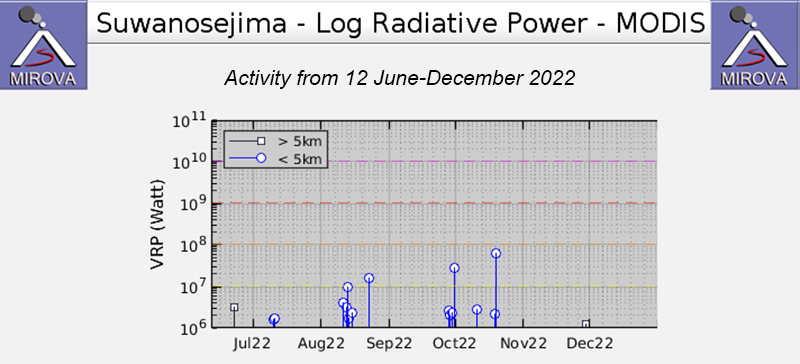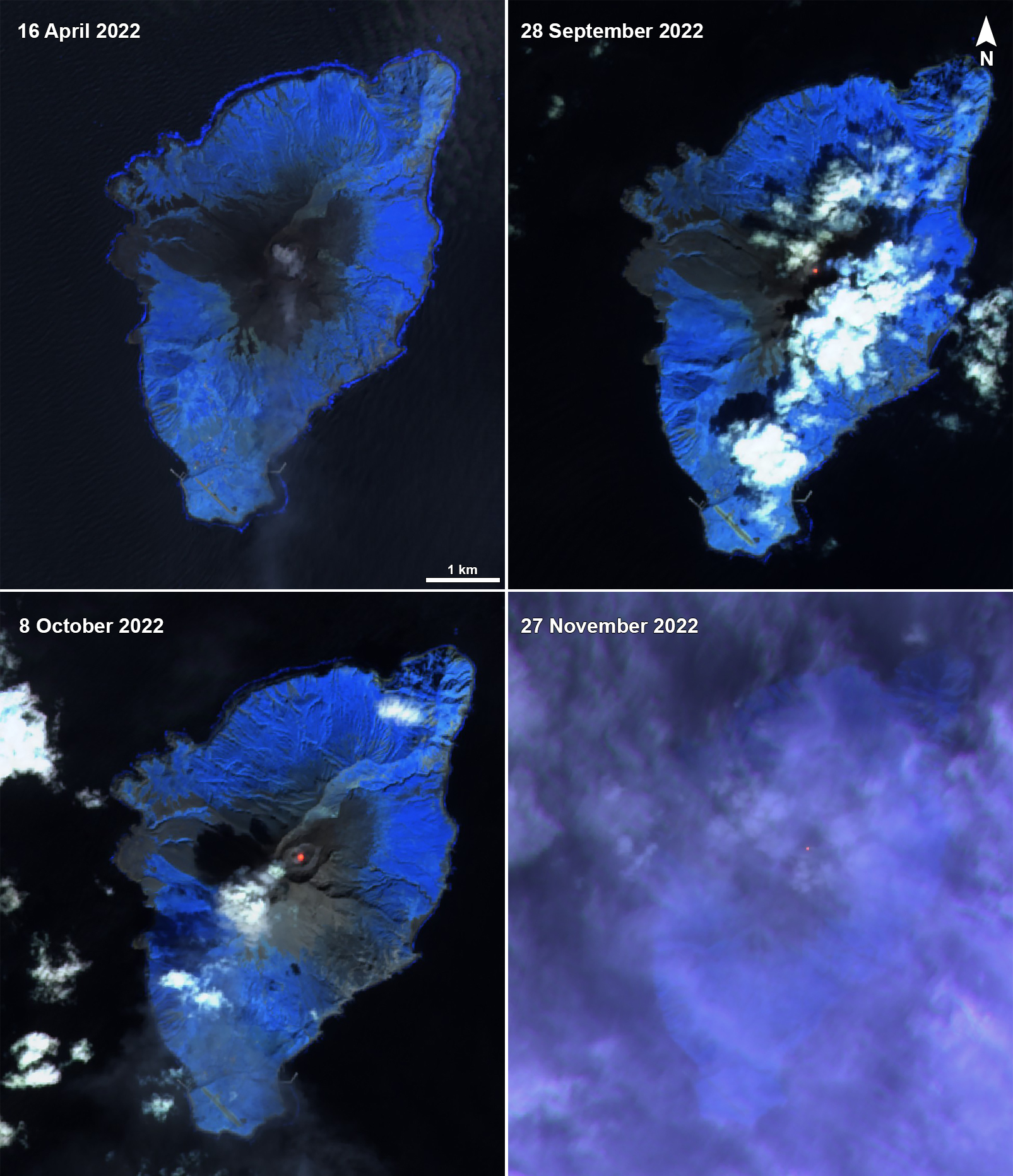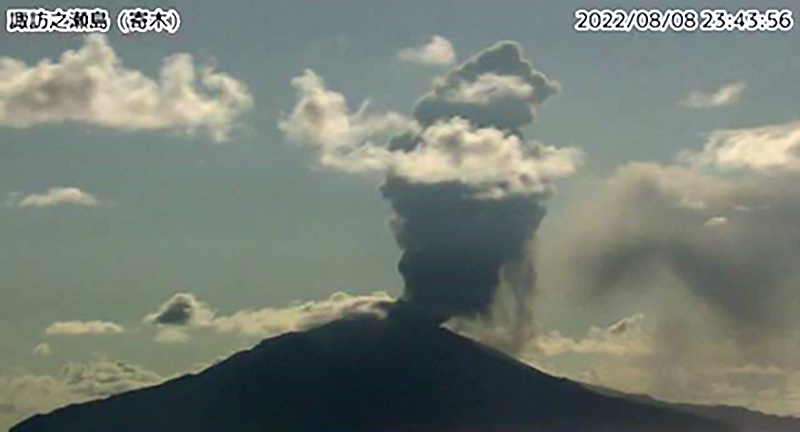Report on Suwanosejima (Japan) — January 2023
Bulletin of the Global Volcanism Network, vol. 48, no. 1 (January 2023)
Managing Editor: Edward Venzke.
Edited by Kadie L. Bennis.
Suwanosejima (Japan) Intermittent explosions, eruption plumes, ashfall, and incandescent ejecta during April-December 2022
Please cite this report as:
Global Volcanism Program, 2023. Report on Suwanosejima (Japan) (Bennis, K.L., and Venzke, E., eds.). Bulletin of the Global Volcanism Network, 48:1. Smithsonian Institution.
Suwanosejima
Japan
29.638°N, 129.714°E; summit elev. 796 m
All times are local (unless otherwise noted)
Suwanosejima, located in the northern Ryukyu Islands, Japan, is an 8-km-long island that consists of a stratovolcano and two historically active summit craters. Volcanism was intermittent for much of the 20th century, characterized by Strombolian explosions, ash plumes, and ashfall. The current eruption began in October 2004 and has recently consisted of frequent explosions, ash plumes, thermal activity, and ashfall (BGVN 47:04). This report updates similar activity of explosions, eruption plumes, ashfall, thermal activity, and seismicity during April-December 2022 based on information from the Japan Meteorological Agency (JMA) and satellite data.
Intermittent explosions were reported in the Otake crater, producing volcanic plumes that rose as high as 3.3 km above the crater rim, which occasionally resulted in ashfall in the nearby Toshima village (3.5 km SSW). Large volcanic blocks were ejected 900 m from the crater center and nighttime crater incandescence was frequently reported. Two thermal hotspots were detected by the MODVOLC thermal alerts system on the NW and NE flanks on 19 October 2022. The MIROVA (Middle InfraRed Observation of Volcanic Activity) Log Radiative Power graph of the MODIS thermal anomaly data showed three brief periods of thermal activity during early July, mid-August, and late September through October (figure 72). Sentinel-2 infrared satellite imagery showed three clear weather days with a thermal anomaly during the reporting period on 28 September, 8 October, and 27 November (figure 73).
Eruptive activity in the Otake crater continued during April; about 123 explosions were detected during the first half of the month. Crater incandescence was visible each night during 1-5 April. The sounds of rumbling and ashfall were occasionally reported in Toshima village, as well as sometimes in areas up to 5 km from the crater. Seismicity consisted of 491 volcanic earthquakes, not including explosion-related earthquakes. An explosion on 4 April at 2241 generated an eruption plume that rose 3.3 km above the crater rim. Large volcanic blocks were ejected as far as 900 m SE from the crater. No eruptive activity was reported during 9-11 and 15-18 April, although emissions rose 700-1,100 m above the crater rim. According to observations conducted by the University of Tokyo, Kyoto University, Toshima village, and JMA, the amount of sulfur dioxide released ranged from 300 to 1,600 tons per day (t/d), which was lower compared to March (3,400 t/d).
One explosion was detected during early May, followed by three more during 20-23 May; there were 33 explosions reported after 22 May through the end of the month. An explosion on 28 May at 0327 produced an eruption plume that rose 1.9 km above the crater rim. Large volcanic blocks were ejected about 500 m S from the crater. Nighttime incandescence was intermittently captured with a high-sensitivity surveillance camera. Rumbling sounds and ashfall were occasionally reported in Toshima village. A total of 417 volcanic earthquakes were detected during the month. Sulfur dioxide emissions had increased slightly compared to April, with 1,200-2,000 t/d emitted.
According to JMA, the number of explosions had decreased after April; there were 21 explosions that were detected dominantly during 2-6 and 30 June. The explosions ejected large volcanic blocks as far as 600 m S from the crater. On 7 June ashfall was observed in Toshima village. During 10-13 June eruption plumes rose as high as 1.5 km above the crater rim and ejected material as far as 300 m from the vent. On 26 June at 1418 an explosion generated an eruption plume that rose 2 km above the crater rim. Nighttime crater incandescence continued. There were 314 volcanic earthquakes detected throughout the month. The amount of sulfur dioxide emissions ranged between 1,000 t/d and 3,700 t/d.
Since mid-April, eruptive activity continued to decrease and as a result, JMA lowered the Volcano Alert Level (VAL) to 2 (on a 5-level scale) on 11 July. The number and intensity of explosions had been variable since early April, but showed an overall decline, and material had not been ejected more than 1 km. Eruption plume heights occasionally exceeded 3 km above the crater rim since July 2021, but these heights had not been observed since mid-April 2022. The number of volcanic earthquakes temporarily increased on 17 May but were generally low. The number of recorded explosions during July was 34 and large volcanic blocks accompanied by explosions were ejected as far as 700 m SW from the crater. Nighttime crater incandescence persisted during both July and August. On 26 July at 2351 a volcanic plume rose more than 1.8 km above the crater rim. Resulting ashfall was reported in Toshima village. The number of volcanic earthquakes detected in the vicinity increased to 526 compared to the previous months. Sulfur dioxide measurements showed that 700-2,500 t/d were released during July and 600-2,200 t/d during August.
Beginning on 2 August, the number of explosions increased; there were 24 explosions detected during 2-7 August. On 11 and 28 August explosions at 0416 and 2151, respectively, ejected large blocks 800 m from the vent. Eruption plumes during 7-8 August rose 2 km above the crater and mixed with weather clouds (figure 74). During 28-29 August three explosions generated ash plumes that rose as high as 1.3 km above the crater rim. Intermittent explosions occurred during August (51 total) and the number of volcanic earthquakes increased to 615.
During September, 88 explosions were recorded; 25 occurred during 24-28 September. The frequency of explosions was greater in September than August. Thermal activity continued to be reported during the night, based on high-sensitivity surveillance cameras. Occasional rumbling sounds and ashfall were observed as well. On 24 September at 1819 an eruption plume rose more than 2 km above the crater rim. An aerial survey was conducted by the Japan Meteorological Agency Mobile Research Team (JMA-MOT) on 29 September in cooperation with the Kagoshima Prefecture reported that a gray-white plume was observed rising above the Mitake crater (figure 75). Additionally, observations made using an infrared thermal imaging device confirmed high temperature areas near the summit, which were interpreted to be the scattered ejecta around the crater. The VAL was raised to 3 (on a 5-level scale) on 28 September. On 30 September at 2141 an explosion ejected large volcanic blocks 900 m S from the crater. The number of volcanic earthquakes around the volcano increased significantly to 1,351 and sulfur dioxide emissions ranged between 500-1,600 t/d.
The number of detected explosions continued to increase during October, particularly with 119 detected during 17-19 October, and a total of 244 recorded through the month. An eruption at 1342 on 8 October produced a volcanic plume that rose 2.4 km above the crater rim. An aerial survey was conducted on 11 October in cooperation with the Kagoshima Prefecture and reported that gray-white plumes continued to rise above the Mitake crater. An explosion at 0513 on 20 October ejected large volcanic blocks to 800 m SW from the crater. Nighttime crater incandescence continued, in addition to occasional rumbling sounds and ashfall in Toshima village. There was an increase in the number of volcanic earthquakes during 25-31 October, with a total of 2,034 events detected. Sulfur dioxide emissions measured between 400 and 2,100 t/d; there were multiple days in which the amount of sulfur dioxide emissions exceeded 2,000 t/d, according to JMA.
Eruptive activity during November and December had notably decreased; 3 explosions were detected. Nighttime crater incandescence persisted, as well as occasional rumbling sounds and ashfall in Toshima village. There were 465 volcanic earthquakes detected during the month. On 4 November at 0137 a volcanic plume rose 2.4 km above the crater rim. An explosion was detected at 2238 on 11 November that generated an eruption plume that rose 1.6 km above the crater rim. An explosion at 0251 on 15 November produced volcanic plumes that rose 1-1.3 km above the crater rim and drifted SE; associated large volcanic blocks were ejected 500 m S from the crater. JMA reported that 700-2,000 t/d of sulfur dioxide emissions were measured during November. During December, activity remained relatively low compared to previous months; no explosions were observed during the month, though nighttime crater incandescence remained visible, according to JMA. Ashfall was occasionally reported in Toshima village. There were 184 volcanic earthquakes detected during the month. An eruption at 0421 on 2 December ejected material as far as 300 m E of the crater. An eruption plume on 3 December rose more than 1.8 km above the crater. Approximately 400-800 t/d sulfur dioxide emissions were measured, which was lower compared to November.
Geological Summary. The 8-km-long island of Suwanosejima in the northern Ryukyu Islands consists of an andesitic stratovolcano with two active summit craters. The summit is truncated by a large breached crater extending to the sea on the E flank that was formed by edifice collapse. One of Japan's most frequently active volcanoes, it was in a state of intermittent Strombolian activity from Otake, the NE summit crater, between 1949 and 1996, after which periods of inactivity lengthened. The largest recorded eruption took place in 1813-14, when thick scoria deposits covered residential areas, and the SW crater produced two lava flows that reached the western coast. At the end of the eruption the summit of Otake collapsed, forming a large debris avalanche and creating an open collapse scarp extending to the eastern coast. The island remained uninhabited for about 70 years after the 1813-1814 eruption. Lava flows reached the eastern coast of the island in 1884. Only about 50 people live on the island.
Information Contacts: Japan Meteorological Agency (JMA), 1-3-4 Otemachi, Chiyoda-ku, Tokyo 100-8122, Japan (URL: http://www.jma.go.jp/jma/indexe.html); MIROVA (Middle InfraRed Observation of Volcanic Activity), a collaborative project between the Universities of Turin and Florence (Italy) supported by the Centre for Volcanic Risk of the Italian Civil Protection Department (URL: http://www.mirovaweb.it/); Hawai'i Institute of Geophysics and Planetology (HIGP) - MODVOLC Thermal Alerts System, School of Ocean and Earth Science and Technology (SOEST), Univ. of Hawai'i, 2525 Correa Road, Honolulu, HI 96822, USA (URL: http://modis.higp.hawaii.edu/); Sentinel Hub Playground (URL: https://www.sentinel-hub.com/explore/sentinel-playground).





